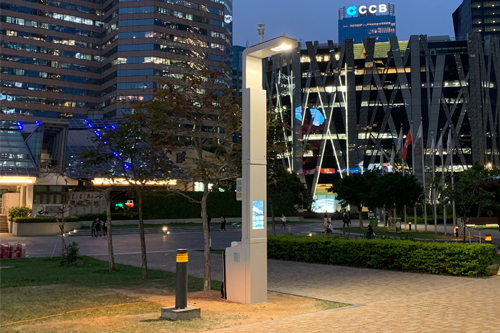In the era of rapid digital transformation, smart cities have emerged as a beacon of progress that embody the transformative potential of advanced technology essential for urban development and liveability.
Smart cities harness advanced technologies to address pain points from urbanisation, enhance quality of life, and promote social and economic growth. Among the many initiatives driven by municipalities, smart street lighting is a critical cog in enabling a sustainable, connected and future-proof smart city ecosystem. By improving energy efficiency, safety and delivering citizen-centric services, smart street lighting paves the way for a host of smart city applications, heralding a greener and better future for cities.

Beyond improving safety with well-lit roads and walkways, smart street lighting leverages advanced technologies to enhance energy and operating efficiency, deliver cost-savings and overall optimisation of city management. Benefits include:
Improve energy efficiency and cost savings: Conventional street lighting accounts for more than 40% of a city’s energy costs. In comparison, smart street lighting that uses LED luminaires and intelligent controls can optimise energy efficiency and yield up to 80% savings in energy expenses for municipalities. It can dim or brighten lights based on real-time conditions, reducing energy usage and wastage.
Increase visibility and operational efficiency: With smart controls and the ability to provide an overview of lighting operations and performance, faults and outages can be swiftly identified and addressed. Notifications are quickly sent to maintenance personnel, accurately pinpointing the specific lights and issues that require attention.
Enhance city services with data-driven insights: When integrated with sensors and IoT devices, connected smart street lightings can collect, aggregate and make sense of valuable data such as environmental parameters, traffic patterns and pedestrian movement, from various sources. This data is then sent to a unified central management platform, where it is analysed and used to optimise city services including traffic and junction management, smart parking and utilities management while enhancing public safety and security. It can also be connected to water sensors to detect abnormal water flow patterns that can indicate pipe leakages. Early leak detection helps to prevent water loss and reduce wastage.
Ensure operational continuity with predictive maintenance: Smart street light management can leverage predictive algorithms to analyse data and identify patterns that indicate ageing or degrading of lighting for proactive and scheduled maintenance. Besides reducing cost of maintenance, it improves the uptime and lifespan of street lights.
Provide city-wide backbone for smart applications: Due to its ubiquity, smart street lightings can serve as a common networked infrastructure and foundation for other smart city applications. By connecting lamp posts to form a wireless sensor network and equipping them with smart sensors, it provides a quick entry point for cities to accelerate the deployment of smart city applications.
Enhance traffic efficiency and safety: Data collected through add-on sensors and signages on smart street light and vehicles can be shared through Vehicle-to-Infrastructure (V2I) communication to provide a more informed travel experience for drivers and other road users, contributing to a safer and more efficient intelligent transport system. V2I is a technology that enables vehicles to communicate with roadside infrastructures such as smart street lights and traffic signal controllers. It allows vehicles and smart street lights to exchange real-time data, improving safety systems for drivers and information dissemination to commuters, and optimising traffic flow.
While the advantages of smart street lighting are evident, choosing the right one can be challenging due to multiple applications and technology platforms in the market.
Many solutions and management platforms in the market are proprietary and lack interoperability. There is also a lack of common standards across communication networks and technologies. Scalability and compatibility of platforms, systems and devices can also be a hindrance to cities.
In addition, data silos among government departments and agencies need to be addressed. With technologies constantly evolving, it is important to avoid getting locked into a single vendor’s solution as this will lead to silos of information, making it challenging to share data which is crucial for smart city transformation.

ST Engineering’s AGIL® Smart Street Lighting Solution addresses the shortcomings of conventional street lighting systems. With its reliable, device-agnostic, data-driven platform and central management system, it provides cities with a one-stop solution for managing street lights, optimising energy consumption, as well as reducing carbon footprint as well as operating and maintenance costs for municipalities and operators.
The solution’s key features include:
Cities that have embraced ST Engineering Urban Solutions’ AGIL Street Lighting Solution have reaped significant benefits. One example is Cleveland in the United States. While the planned deployment of 61,000 smart street lights is still ongoing, the city has reduced annual street light operating costs by 20%, and energy consumption by 50%.
In Rio de Janeiro, Brazil, ST Engineering Urban Solutions is a technology partner to the Smart Luz consortium which was awarded a concession to operate, maintain and modernise the city’s public lighting infrastructure. The AGIL Smart Street Lighting Solution and AGIL IoT Platform will be deployed to connect and manage more than 300,000 LED street lights across the city. When completed, it will help the city to achieve up to 70% in energy savings. The platform also has the potential to manage over 25,000 devices and sensors, and enable Wi-Fi hotspots, waste management and traffic junction sensing for future smart city applications.

Municipalities and key industry stakeholders need to see the benefits beyond smart street lighting – it serves as an important digital backbone that enables various smart city applications and use cases. Besides addressing increasing challenges from urbanisation and climate change, it sets the stage for cities to fast-track positive outcomes that benefit citizens and communities.
Discover how ST Engineering’s AGIL suite of smart city solutions play a vital role in creating greener, more efficient and safer cities.
Contact us

Join us in this webinar to hear our domain experts provide insights on how we can harness the power of smart street lighting to address smart city

1 hr 21 minutes